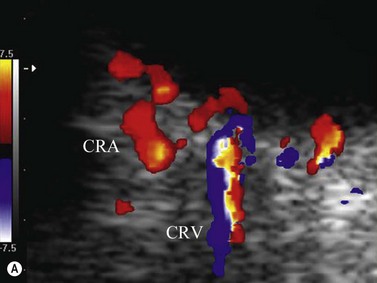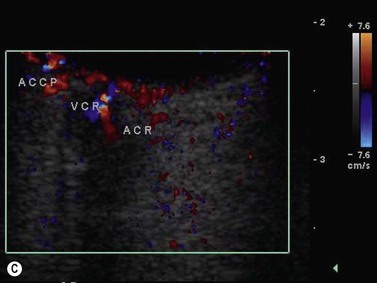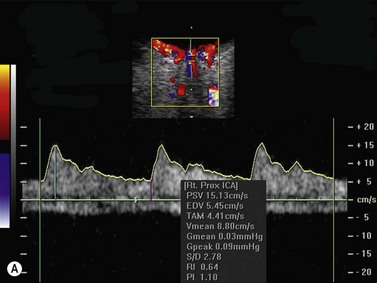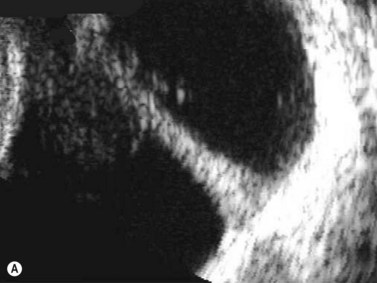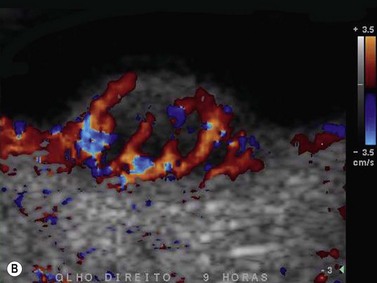Chapter 5 Doppler and Contrast Agents
Introduction
Color Doppler imaging (CDI) or color Doppler ultrasonography (CDUS) is a useful diagnostic tool in evaluating ocular and orbital diseases (Table 5.1). Based on its capacity to combine two-dimensional B-mode image and functional blood flow analysis, this non-invasive method is suitable to study vascular abnormalities involving the central retinal artery, central retinal vein, posterior ciliary arteries, ophthalmic artery, and superior ophthalmic vein. It is also applied to assess hemodynamic changes in orbital vasculature. Furthermore, in comparison to other imaging methods such as computerized tomography (CT) and magnetic resonance imaging (MRI), CDI has the advantage of not using radiation. Ease of use and portability of equipment are also distinct advantages with CDI. Most importantly, CDI offers the capability of visualizing ocular and orbital vessels not frequently assessed by other methods.
| Color Doppler | Velocity information is displayed as a color code and superimposed on top of a B-mode image |
| Continuous Doppler | Continuous generation of ultrasound waves coupled with continuous ultrasound reception performed by two different transducer heads (crystals) without bidimensional (2D) discrimination |
| Pulsed Doppler | Doppler information is sampled from a small sample volume (defined in 2D image), and presented on a timeline. It uses a transducer that alternates transmission and reception |
| Duplex scanning | A common name for the simultaneous presentation of 2D and Doppler information |
| Spectral analysis | Time × frequency diagram representative of blood flow in a cardiac cycle |
| Power Doppler | Improved technology in Doppler sonography that has the advantages of less direction dependence, higher sensitivity, and better contrast of vasculature |
More recently, intravenous contrast agents have been used to enhance the properties of the diagnostic CDI. The contrast agents increase the amount of sound scattering in the blood, thus increasing the amplitude of the back-scattered signal by 20–30 dB, facilitating identification of blood flow within the neoplasms.1–3
CDI: background and physical considerations
The Doppler effect is the property of sound waves or electromagnetic waves to undergo changes in their velocity of propagation by the movement of a given reflector. This is a physical principle first described by Johann Christian Doppler, an Austrian scientist in 1842.4 The Doppler effect, or Doppler shift is applied in several areas of science such as astronomy, radar, and medical imaging.
Doppler ultrasonography is based on ultrasound wave reflection by a reflector (e.g. a blood column), which moves at a given velocity in one direction in reference to a transducer. The frequency of the emitted sound is altered by the velocity of blood particles. This frequency is increased when the blood flow is moving towards the transducer and decreases when blood moves away. Calculation of the magnitude of reflected sound yields an estimate of blood flow; the faster the blood flow (reflector), the greater the difference between the reflected and emitted frequencies (Doppler shift – ΔF), as demonstrated by the formula:5
which can be rearranged to give:
This equation is valid when transducer and reflector are parallel. Although orbital vessels are frequently parallel to the ultrasound beam, angle correction should be used when needed. Newer versions of the equipment automatically adjust for angle correction in the velocity calculations. Improvements in CDI techniques have tried to overcome limitations, such as angle dependence and difficulty in separating background noise from true flow in slow-flow states. Power Doppler sonography is able to evaluate low blood flow and has relative angle independence thereby offering superior depiction of tissue perfusion.6,7 Power Doppler sonography may be particularly valuable in assessing small vasculature of the eye.
Examination technique and device parameters
Color flow information is used to depict the major vascular structures in the orbit, which can be displayed in either blue or red. Color parameters can be subjectively assigned regarding the direction of the blood flow with respect to the transducer. In general, the flow moving towards the transducer is displayed in red, and away from it, is showed in blue (Figure 5.1). Orbital vessels are frequently parallel to the sound beam, thus, for the majority of the time arteries are displayed in red and veins in blue. A pulsed Doppler spectral analysis is also obtained to distinguish between arterial and venous flow (Figure 5.2).
CDI application in ophthalmology dates from the late 1980s. It is applied to evaluate several ocular and orbital diseases (Table 5.2).8–20 Several studies have demonstrated CDI velocities of orbital vessels in normal eyes with relatively good reproducibility (Table 5.3).10,11,15,17,20–23
Table 5.2 Indications for Color Doppler imaging in ophthalmology.
| Intraocular disease |
Clinical applications
Retinal detachment
CDI can add useful information in differentiating a detached retina from a dense vitreous band through retinal vasculature depiction in retinal detachment (Figure 5.3).24,25
Persistent fetal vasculature
Persistent fetal vasculature or persistent hyperplastic primary vitreous has been studied with CDI, adequately demonstrating the patency of the persistent hyaloid artery.26,27 Besides diagnosis, hyaloid artery flow assessment can guide the surgeon in vitreoretinal surgery planning (Figure 5.4).
Intraocular tumors
Besides clinical parameters, ancillary examination techniques provide critical information that helps to establish accurate diagnosis, plan radiation treatment, and reliably follow intraocular tumors, such as uveal melanoma, metastasis, and choroidal hemangioma. Conventional B-mode and standardized A-mode ultrasonography are considered the gold-standard for assessing qualitative and quantitative characteristics of intraocular lesions including tumor vascularization (Chapter 11).
Tumor-associated vasculature is classically assessed by intravenous angiography and indocyanine angiography, which require clear media and no contraindication for intravenous contrast media. CDI has come to play an important role in tumor blood flow assessment, not only in displaying tumor microvasculature (color Doppler signals) but also in allowing functional analysis (spectral analysis) (Figure 5.5).28–33 Differential diagnosis between various intraocular tumors based on their vasculature pattern is still being defined. However a distinction between a non-tumoral process, such as a large hemorrhagic choroidal detachment, and a tumor is facilitated by this method, by identifying internal blood flow (Figure 5.6).
Some investigators have correlated CDI characteristics with tumor response after treatment.20,34,35 Tranquart et al evaluated 165 patients treated by radiation therapy (brachytherapy or proton beam therapy) as conservative treatment for uveal melanoma.20



